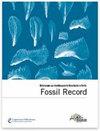A new species of baenid turtle from the Early Cretaceous Lakota Formation of South Dakota
IF 2.1
4区 地球科学
Q1 PALEONTOLOGY
引用次数: 15
Abstract
Abstract. Baenidae is a clade of paracryptodiran turtles known from the late Early Cretaceous to Eocene of North America. The proposed sister-group relationship of Baenidae to Pleurosternidae, a group of turtles known from sediments dated as early as the Late Jurassic, suggests a ghost lineage that crosses the early Early Cretaceous. We here document a new species of paracryptodiran turtle, Lakotemys australodakotensis gen. and sp. nov., from the Early Cretaceous (Berriasian to Valanginian) Lakota Formation of South Dakota based on a poorly preserved skull and two partial shells. Lakotemys australodakotensis is most readily distinguished from all other named Late Jurassic to Early Cretaceous paracryptodires by having a broad, baenid-like skull with expanded triturating surfaces and a finely textured shell with a large suprapygal I that laterally contacts peripheral X and XI and an irregularly shaped vertebral V that does not lap onto neural VIII and that forms two anterolateral processes that partially separate the vertebral IV from contacting pleural IV. A phylogenetic analysis suggests that Lakotemys australodakotensis is a baenid, thereby partially closing the previously noted gap in the fossil record.南达科他州早白垩世拉科塔组的一新种贝贝龟
摘要贝龟科是北美早白垩纪晚期至始新世所知的副隐地龟的一个分支。从早在晚侏罗世的沉积物中就已发现的龟科和胸甲科的姐妹群关系表明,在早白垩纪早期,有一个幽灵谱系。本文基于一个保存较差的头骨和两个不完整的壳,记录了南达科他州早白垩世(Berriasian - Valanginian)拉科塔组的一种新种——Lakotemys australodakotensis gen. and sp. nov.。最容易与所有其他已命名的晚侏罗世到早白垩世的sparacryptodires区分开来的是,它有一个广泛的,
本文章由计算机程序翻译,如有差异,请以英文原文为准。
求助全文
约1分钟内获得全文
求助全文
来源期刊

Fossil Record
PALEONTOLOGY-
CiteScore
3.60
自引率
7.10%
发文量
18
审稿时长
14 weeks
期刊介绍:
Fossil Record (FR) is the palaeontological journal of the Museum für Naturkunde Berlin. This journal was founded in 1998 under the name Mitteilungen aus dem Museum für Naturkunde Berlin, Geowissenschaftliche Reihe and appears with two issues each year. Fossil Record publishes original papers in all areas of palaeontology including the taxonomy and systematics of fossil organisms, biostratigraphy, palaeoecology, and evolution. All taxonomic groups are treated, including invertebrates, microfossils, plants, and vertebrates.
 求助内容:
求助内容: 应助结果提醒方式:
应助结果提醒方式:


